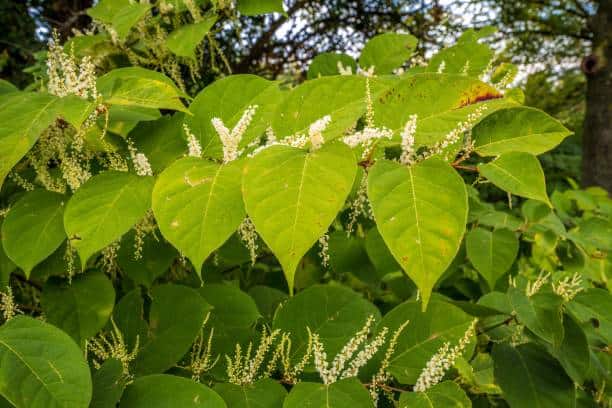Why is Japanese Knotweed Such a Big Problem
Exploring the Impact and Risks of This Invasive Species
Discover the reasons behind the notorious reputation of Japanese Knotweed.
These non-native plant species are causing significant damage to properties, wildlife habitats, and ecosystems.
Japanese knotweed is a highly invasive plant species causing a significant problem across the UK and other parts of the world. This plant originates from East Asia and was introduced to the UK in the 19th century as an ornamental plant. However, it has quickly become one of the most destructive and problematic invasive plant species. Due to its aggressive growth, resistance to control measures, and ability to cause damage to buildings, infrastructure, and the environment. This article will explore why Japanese Knotweed is such a big problem and its risks and impact on our surroundings.
What is Japanese Knotweed?
Japanese Knotweed, or Fallopia japonica, is a fast-growing, herbaceous perennial plant that can grow up to 10cm per day in the summer. It is characterised by its bamboo-like stems, heart-shaped leaves, and clusters of white flowers. Japanese knotweed can grow up to 3-4 meters tall and spread quickly through rhizomes, as well as underground stems that can grow up to 7 meters long. Rhizomes can also survive up to 20 years, making controlling the plant extremely difficult.
Why is Japanese Knotweed such a big problem?
-
Property Damage
One of the most significant risks associated with Japanese Knotweed is the damage it can cause to properties. The plant’s rhizomes can grow through foundations, walls, and pipes, damaging buildings and infrastructure. This can lead to costly repairs and, in severe cases, make properties uninhabitable. Due to its significant impact on property values, the presence of Japanese Knotweed can also affect property transactions and mortgage applications.
-
Ecological Damage
Japanese Knotweed can also cause significant damage to ecosystems by outcompeting native plants for resources, reducing biodiversity, and altering habitats. The plant’s fast growth and dense foliage can create a canopy that shades out other plants, preventing them from growing. As a result, wildlife habitats can be destroyed, and species that depend on those habitats can be negatively impacted.
-
Legal Risks
The presence of Japanese Knotweed on private or public land can also lead to legal risks. Under UK law, it is illegal to plant or cause Japanese Knotweed to grow in the wild. Landowners are also responsible for controlling the spread of the plant and preventing it from damaging neighbouring properties. Failure to do so can result in fines and legal action.
-
Difficulty in Eradication
Due to its invasive nature and the resilience of its rhizomes, Japanese Knotweed can be challenging to eradicate. Traditional control measures, such as cutting and chemical treatments, are often ineffective and can exacerbate the problem by spreading the plant further. Controlling Japanese Knotweed can be time-consuming and costly, usually requiring specialist expertise and equipment.
FAQs
Q: Is Japanese Knotweed poisonous? A: Japanese Knotweed is not poisonous to humans or animals. However, it can cause damage to buildings and infrastructure and hurts ecosystems and biodiversity.
Q: Can Japanese Knotweed be removed by cutting it down? A: Cutting Japanese knotweed can help reduce the size of the plant and make it easier to control. However, cutting alone is not enough to eradicate the plant as it can regrow from rhizomes left in the soil.
Q: Can Japanese Knotweed be composted? A: Japanese Knotweed should not be composted or disposed of in the regular garden waste
-
Chemical Treatments
Chemical treatments are one of the most effective ways of controlling Japanese Knotweed. Glyphosate is a commonly used herbicide that can kill the plant. However, specialist equipment and knowledge are required to ensure the chemical is used safely and effectively.
-
Physical Removal
Physical removal of Japanese Knotweed involves excavating the soil and removing the rhizomes. This method is often used when chemical treatments are inappropriate or when the risk of environmental damage is high. However, this method can be costly and disruptive, and care must be taken to remove all rhizomes.
-
Combination Approach
A combination approach, using chemical treatments and physical removal, can often be the most effective way to control Japanese Knotweed. This approach can help reduce the number of chemical treatments required, minimise the risk of environmental damage, and ensure the plant is eradicated.
Conclusion
In conclusion, Japanese Knotweed is a significant problem due to its aggressive growth, resilience to control measures, and the damage it can cause to properties, wildlife habitats, and ecosystems. As a non-native species, Japanese Knotweed has no natural predators in the UK, and without effective control measures, it can continue to spread and cause damage. It is essential to take Japanese Knotweed seriously and seek professional advice if you suspect it is present on your property or land. Effective control measures can help to eradicate the plant and minimise the risk of damage to your surroundings.
